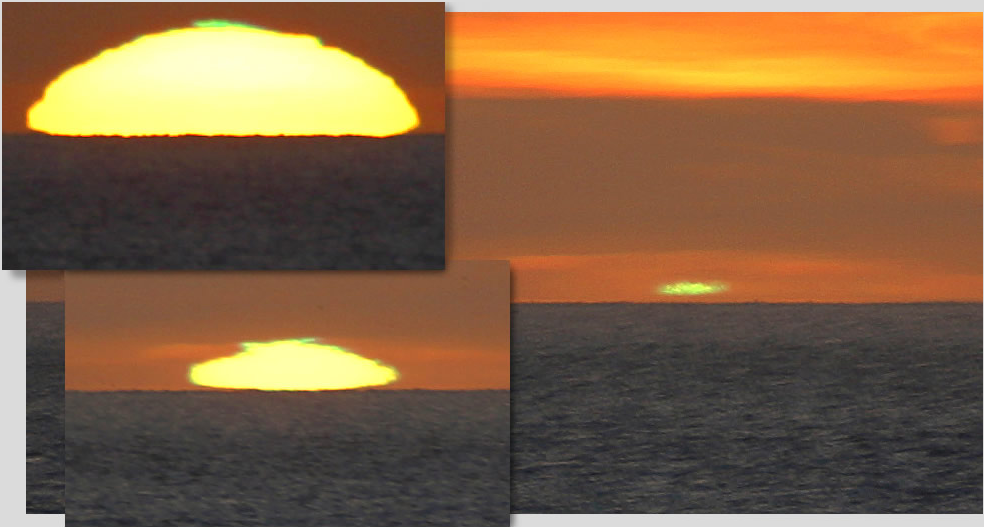Green flash
Exploring the Phenomenon of the Green Flash in Atmospheric Optics
The green flash is a captivating and elusive phenomenon that occurs during sunrise or sunset, when the last glimpse of the sun appears as a vibrant green spot on the horizon. While it may sound like a figment of imagination or a work of fiction, the green flash is a real occurrence in atmospheric optics that has fascinated scientists and observers alike for centuries. In this article, we will delve into the intricacies of the green flash, exploring its causes, variations, and the conditions required for its observation.
Understanding the Green Flash
The green flash is a result of the dispersion of sunlight by the Earth's atmosphere. As the sun sets or rises, its light passes through a greater thickness of atmosphere, causing the shorter wavelengths of light, such as blue and green, to scatter more than the longer wavelengths. This scattering phenomenon is known as Rayleigh scattering.
As a result of Rayleigh scattering, the green light becomes more prominent during the final moments of sunset or sunrise, leading to the appearance of a green flash. However, it is important to note that the green flash is not always visible. It requires specific atmospheric conditions and a clear view of the horizon to be observed.
Variations of the Green Flash
The green flash can manifest in different forms, each offering a unique spectacle to those fortunate enough to witness it. One common variation is the "inferior mirage" green flash, where the image of the setting or rising sun appears distorted due to temperature inversion layers in the atmosphere. This distortion creates a mesmerizing display of green light just above the horizon.
Another variation is the occurrence of multiple green flashes before the sun completely disappears. These additional flashes, known as "mock mirages," are often observed seconds before the main green flash. They are believed to be caused by vertical waves in the atmosphere that distort temperature inversion layers, resulting in intermittent bursts of green light.
The Conditions for Observing the Green Flash
Observing the green flash requires specific atmospheric conditions and careful preparation. Here are some factors that contribute to the visibility of this phenomenon:
-
Clear Skies: A cloudless sky is essential for a clear view of the horizon and the sun's final moments.
-
Stable Atmosphere: A stable atmosphere with minimal turbulence allows for the formation of well-defined temperature inversion layers, which are crucial for the occurrence of the green flash.
-
Unobstructed Horizon: An unobstructed view of the horizon is necessary to observe the green flash. Buildings, trees, or mountains can hinder visibility and make it challenging to witness this phenomenon.
-
Patience and Timing: The green flash occurs in a matter of seconds, often lasting less than a minute. Observers must time their observation precisely and remain patient to catch this fleeting spectacle.
Famous Observations and Cultural Significance
Throughout history, the green flash has captivated the imaginations of people across cultures. Numerous accounts of this phenomenon can be found in literature, art, and folklore. Notable figures such as Jules Verne and Mark Twain have referenced the green flash in their works, adding to its mystique and cultural significance.
The green flash has also been a subject of scientific study and observation. Researchers have documented and analyzed various instances of the green flash, contributing to our understanding of atmospheric optics and the behavior of light in the Earth's atmosphere.
Capturing the Green Flash
In recent times, advancements in photography have allowed for stunning visual representations of the green flash. Photographers equipped with high-speed cameras and precise timing techniques have been able to freeze this elusive phenomenon in captivating images. These photographs not only serve as scientific records but also showcase the beauty and wonder of the green flash.
Conclusion
The green flash is a captivating natural phenomenon that occurs during sunrise or sunset, adding a touch of magic to the transition between day and night. Understanding its causes and variations enhances our appreciation for the wonders of atmospheric optics. While observing the green flash requires specific conditions and careful preparation, the rewards of witnessing this fleeting spectacle are undoubtedly worth the effort. So, the next time you find yourself at the right place and time, keep your eyes on the horizon, and you may just catch a glimpse of the mesmerizing green flash.

Close ups from Florian Schaaf's North Sea sunset sequence. The overall sunset was an inferior mirage type ending in a classical green flash close to the sea horizon. However, two other green flashes occurred 42 and 11s before the sun disappeared. The earlier flashes are mock mirages and probably produced by temperature inversion layers distorted by vertical waves in the atmosphere.
Note: this article has been automatically converted from the old site and may not appear as intended. You can find the original article here.
Reference Atmospheric Optics
If you use any of the definitions, information, or data presented on Atmospheric Optics, please copy the link or reference below to properly credit us as the reference source. Thank you!
-
<a href="https://atoptics.co.uk/blog/green-flash-2/">Green flash</a>
-
"Green flash". Atmospheric Optics. Accessed on December 26, 2024. https://atoptics.co.uk/blog/green-flash-2/.
-
"Green flash". Atmospheric Optics, https://atoptics.co.uk/blog/green-flash-2/. Accessed 26 December, 2024
-
Green flash. Atmospheric Optics. Retrieved from https://atoptics.co.uk/blog/green-flash-2/.